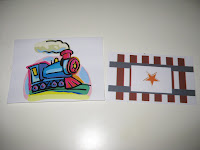Here are some ideas for teaching mathematical outcomes in the location, direction and movement topic in the strand of space:
S1.2 Students follow and give simple directions to move through familiar environments and located and place objects in those environments.
S2.2 Students interpret and create simple maps, plans and grids to follow and give directions, and to locate or arrange places or objects.
The learning sequence:Step 1: Discuss the directional terms such as forwards, backwards, left and right, to assess children's understandings of those terms.
 Set 2:
Set 2: Set up a grid using hula-hoops. Place an object, e.g. teddy-bear in one of the hoops, then ask a child-volunteer to be a robot, who can only move by recieving directions from their robot master.


The robot master can be you (the teacher) to begin with. The robot master's role is to give directions to the robot, so that the robot can navigate through the hula-hoop grid in order to rescue the teddy-bear. The directions should include position language such as "Move forward one step. Take one step the right. Then move forward two steps. Then take one step the left." and so forth.
You can introduce other complications to make the game more difficult, e.g. mark some of the hoops as being "lava hoops" which the robot cannot pass through. The robot master must navigate the robot to the teddy-bear without going through the lava spots.

The next step in the learning sequence is to ask the children to map out the route which they have taken. It is a good idea to provide the children with pre-drawn grids so that they can concentrate on the mathematical aspects of mapping.

After the children have completed their maps ask them to use their maps to describe the route to their friends as they follow the directions either on the grid or on a blank grid/map.
It is important to remember that the concept of space concerns more than just shapes - it includes developing understandings about direction, location and movement too.
Robot Navigation the boardgame:
I turned this game into a boardgame to help children visualise what they are doing now that they have experienced moving in differnt directions. It was also designed as a resource to teach the children about more complex directional language, such as "anti-clockwise" and "clockwise".
Aim: For each player to navigate their robot to the pot of gold (symbolised by the yellow spot).
How to play:Each player is given 4 position cards (yellow) and 4 step cards (green) at the beginning of the game.



Players can only move their robot by playing step cards and/or position cards, e.g. a player may play one “to the left” position card and one “1 step” step card to move a robot one step to the left.

changes to

Robots can also rotate using position cards, e.g. a quarter-turn clockwise, half-turn anti-clockwise etc. But rotation cards cannot be used in conjunction with a step card, i.e. if a player rotates his/her robot, they must wait till the next turn to move the robot steps in any direction.

changes to

(after playing "quater-turn anticlockwise" card)
Each player must replace the cards they play by picking up another card from the deck.
Red spots symbolise lava hot-spots which must be avoided.
If another robot is blocking the path a player planned to take, they cannot land on, or pass through that space.
If a robot cannot make a valid move, that player may choose to discard one position or step card and pick up a new one.



































